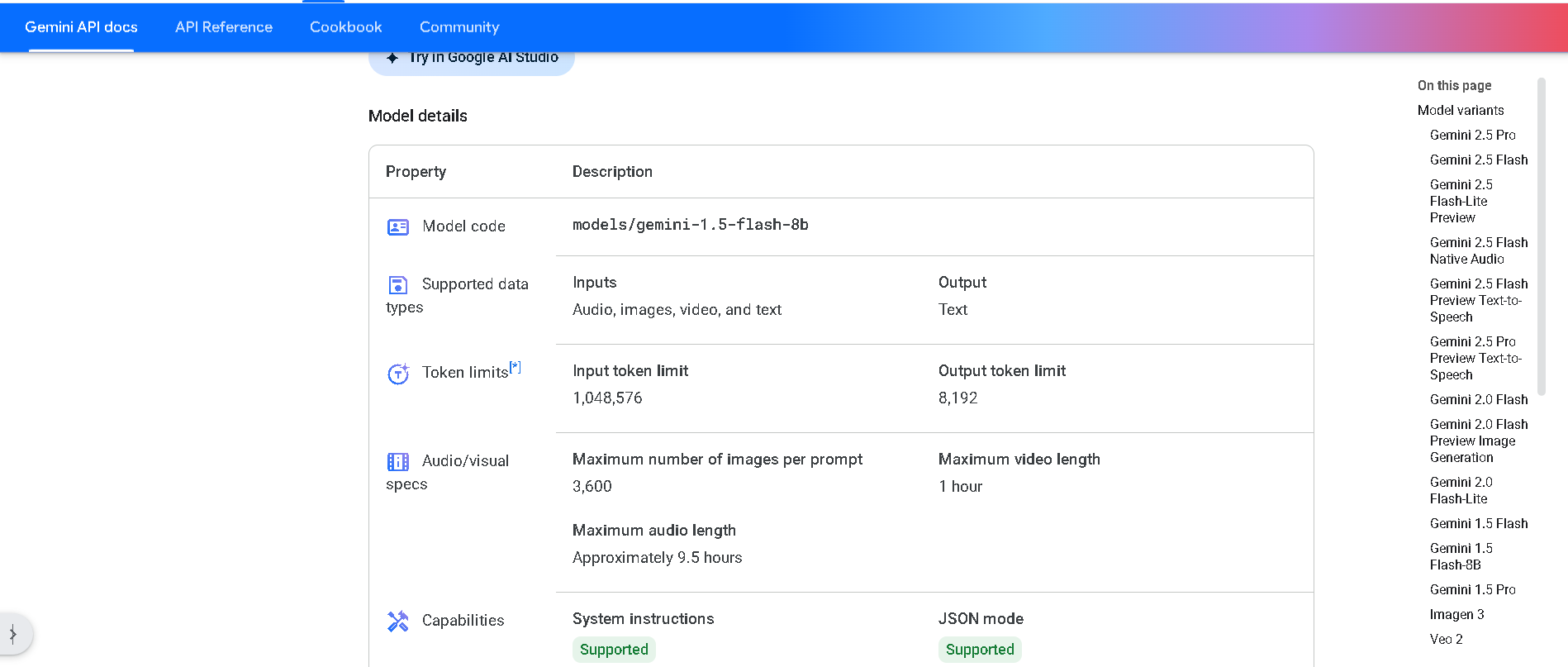
- Enterprise Developers & API Users: Ideal for low-cost, high-volume applications like chatbots, transcription, summarization, and multimodal pipelines.
- Content & Data Teams: Great for large document summarization, image captioning, and multimodal content processing at scale.
- SaaS & High-Throughput Platforms: Power real-time applications with fast responses and minimal compute cost.
- Researchers & Analysts: Suitable for processing hours of audio/video or millions of words with long-context understanding.
- Cost-Conscious Innovators: Offers flagship capabilities with lower resource usage and price per token.
How to Use Gemini 1.5 Flash-8B?
- Access the Model: Now generally available via Google AI Studio and Gemini API under `gemini-1.5-flash-8b`.
- Submit Multimodal Inputs: Send text, image, audio, or video prompts—up to 1 million tokens.
- Optimize for Volume: Benefit from doubled rate limits (4,000 RPM), low latency, and efficient throughput.
- Monitor Costs: Pricing is $0.0375 per M input tokens and $0.15 per M output tokens (for <128K prompts); caching offers $0.01 per M tokens.
- Scale Up Easily: Tune for chat, transcription, and summarization at high volume with built-in function calling and tool support.
- Great Cost Efficiency: Achieves cheapest “intelligence” per token with half the price of standard Flash.
- High Volume through Labelling: 2× rate limits—4,000 requests/minute—ideal for scale-out systems.
- Low Latency: Faster initial response on small tasks, ideal for interactive systems.
- Multimodal & Long Context: Handles diverse input types within a 1 million token window, enabling deep document understanding.
- Production-Ready: Flash-8B closes the performance gap to full Flash while minimizing cost and overhead.
- Lowest cost-per-token solution in Gemini family
- Doubled rate limits for high-demand environments
- Supports huge, multimodal contexts (1M tokens)
- Designed for real-time text, transcription, and summarization
- Production-ready in AI Studio and via API
- Intelligence slightly lower than full Flash or Pro model
- Best for high‑volume tasks; not suited for deep reasoning
- Long-output token limit capped at 8K in some cases
Free
$ 0.00
API
Custom
- Input Price: 1) $0.0375, prompts <= 128k tokens 2) $0.75, prompts > 128k tokens
- Output Price: 1) $0.15, prompts <= 128k tokens 2) $0.30, prompts > 128k tokens
- Context Caching Price: 1) $0.01, prompts <= 128k tokens 2) $0.02, prompts > 128k tokens
- Context caching storage: $0.25 per hour
- Tuning Price: Token prices are the same for tuned models. Tuning service is free of charge.
- Grounding with Google search: $35 / 1K grounding requests
Proud of the love you're getting? Show off your AI Toolbook reviews—then invite more fans to share the love and build your credibility.
Add an AI Toolbook badge to your site—an easy way to drive followers, showcase updates, and collect reviews. It's like a mini 24/7 billboard for your AI.
Reviews
Rating Distribution
Average score
Popular Mention
FAQs
Similar AI Tools
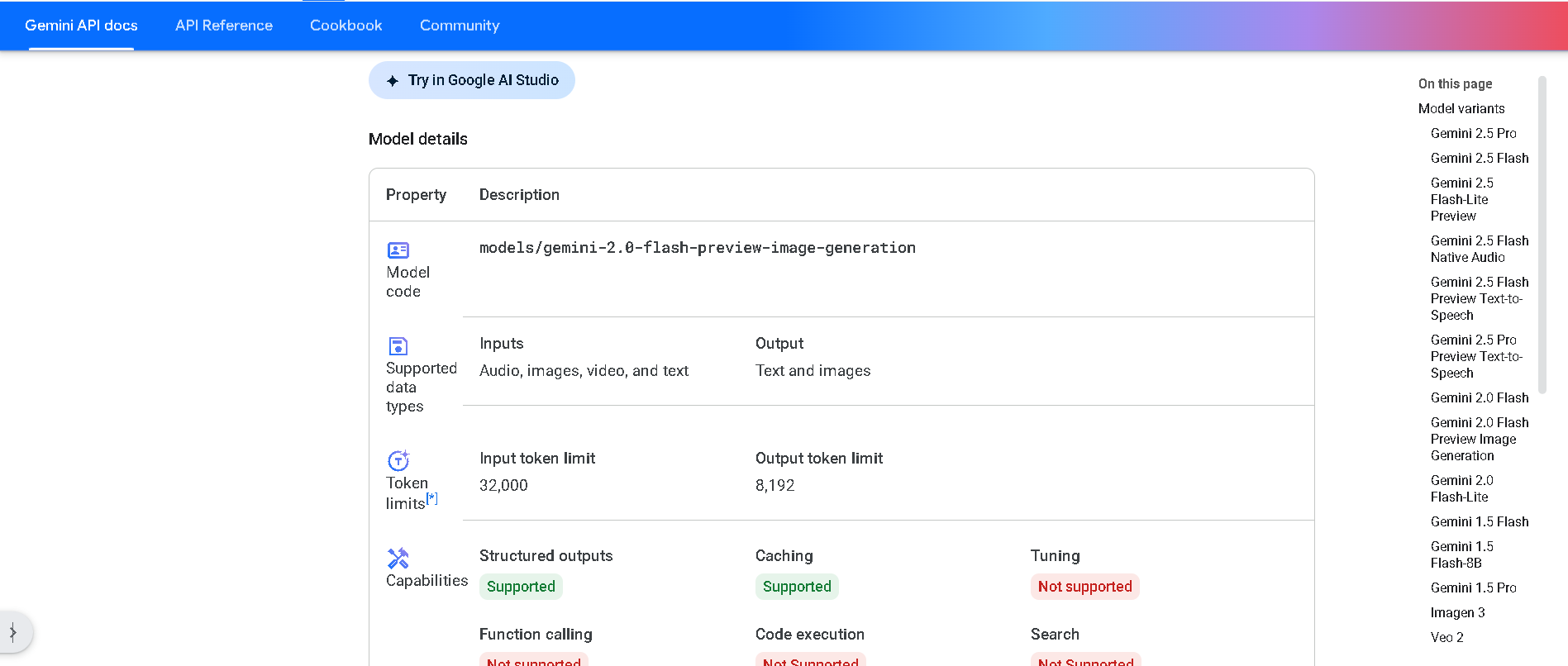
Gemini 2.0 Flash Preview Image Generation is Google’s experimental vision feature built into the Flash model. It enables developers to generate and edit images alongside text in a conversational manner and supports multi-turn, context-aware visual workflows via the Gemini API or Vertex AI.


Gemini 2.0 Flash P..
Gemini 2.0 Flash Preview Image Generation is Google’s experimental vision feature built into the Flash model. It enables developers to generate and edit images alongside text in a conversational manner and supports multi-turn, context-aware visual workflows via the Gemini API or Vertex AI.


Gemini 2.0 Flash P..
Gemini 2.0 Flash Preview Image Generation is Google’s experimental vision feature built into the Flash model. It enables developers to generate and edit images alongside text in a conversational manner and supports multi-turn, context-aware visual workflows via the Gemini API or Vertex AI.
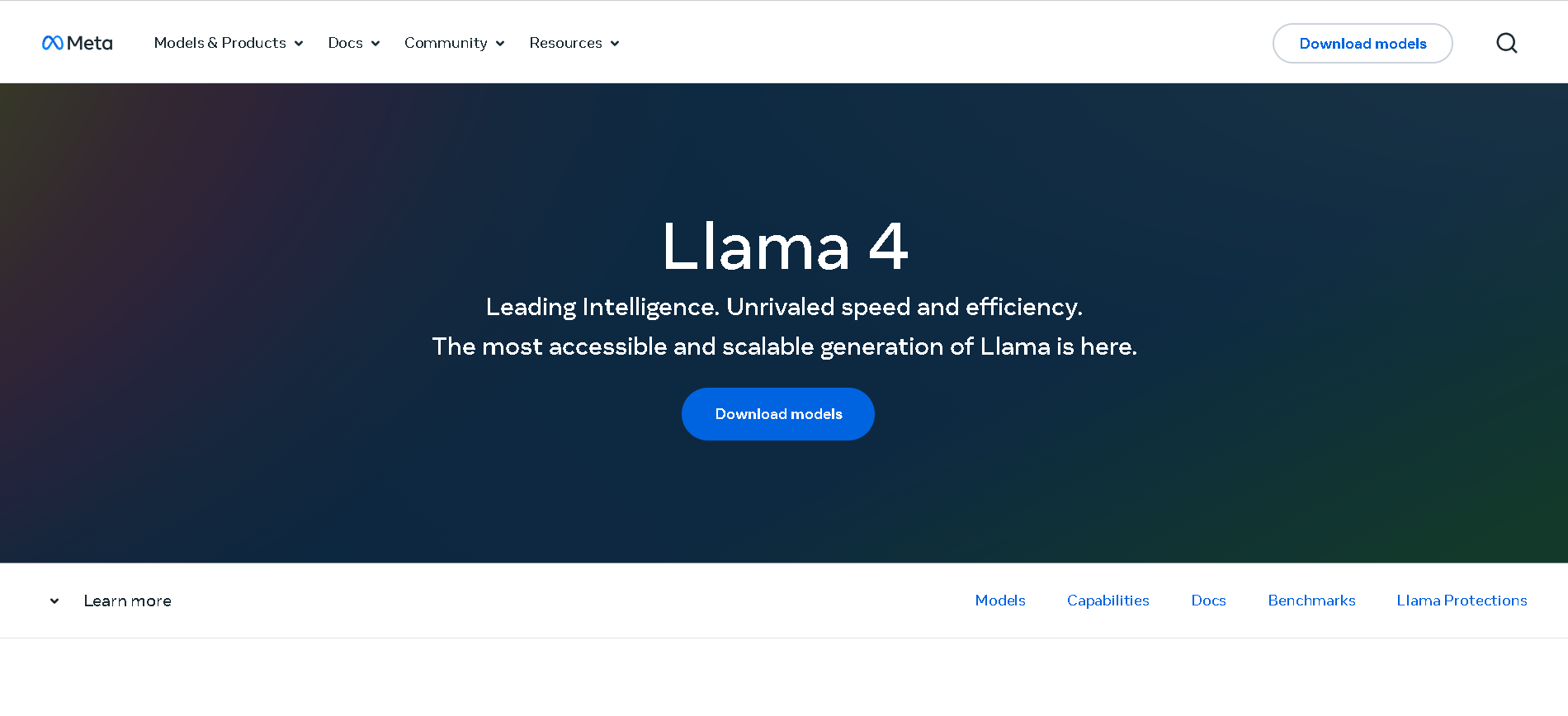
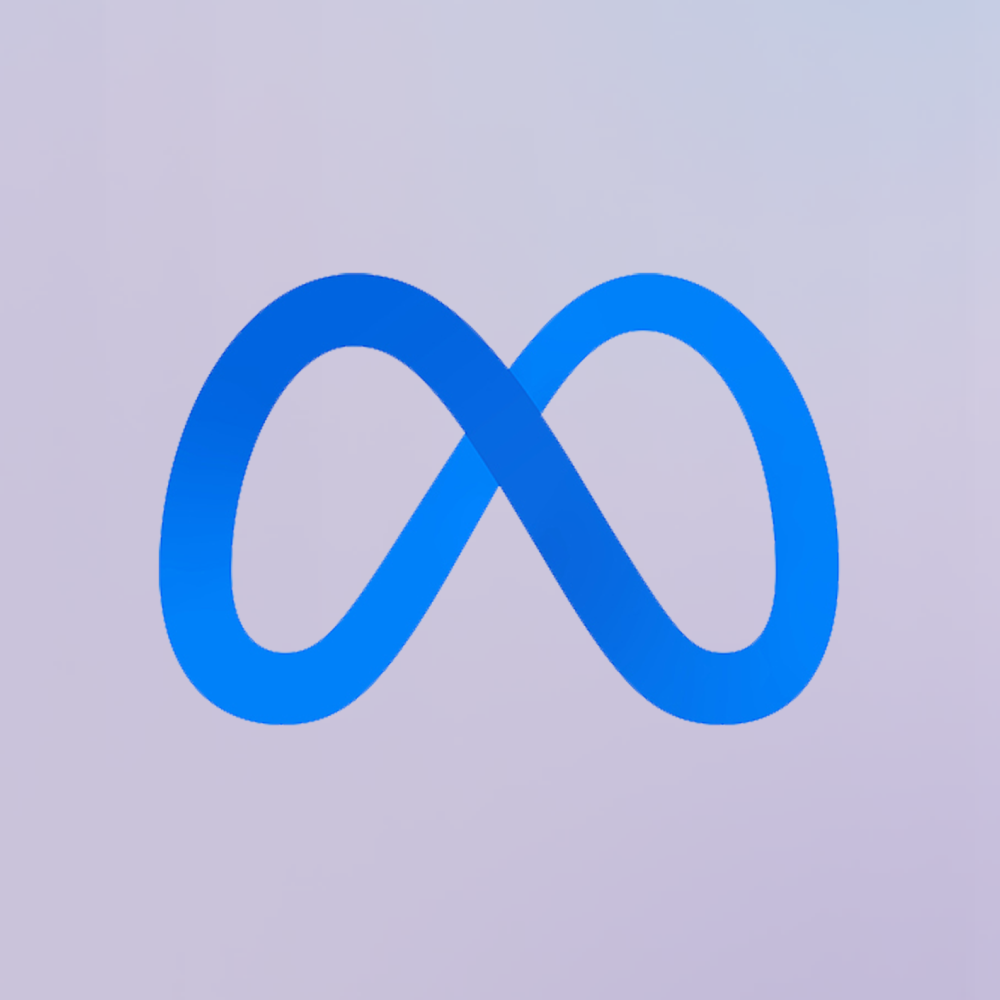
Meta Llama 4
Meta Llama 4 is the latest generation of Meta’s large language model series. It features a mixture-of-experts (MoE) architecture, making it both highly efficient and powerful. Llama 4 is natively multimodal—supporting text and image inputs—and offers three key variants: Scout (17B active parameters, 10 M token context), Maverick (17B active, 1 M token context), and Behemoth (288B active, 2 T total parameters; still in development). Designed for long-context reasoning, multilingual understanding, and open-weight availability (with license restrictions), Llama 4 excels in benchmarks and versatility.


Meta Llama 4
Meta Llama 4 is the latest generation of Meta’s large language model series. It features a mixture-of-experts (MoE) architecture, making it both highly efficient and powerful. Llama 4 is natively multimodal—supporting text and image inputs—and offers three key variants: Scout (17B active parameters, 10 M token context), Maverick (17B active, 1 M token context), and Behemoth (288B active, 2 T total parameters; still in development). Designed for long-context reasoning, multilingual understanding, and open-weight availability (with license restrictions), Llama 4 excels in benchmarks and versatility.


Meta Llama 4
Meta Llama 4 is the latest generation of Meta’s large language model series. It features a mixture-of-experts (MoE) architecture, making it both highly efficient and powerful. Llama 4 is natively multimodal—supporting text and image inputs—and offers three key variants: Scout (17B active parameters, 10 M token context), Maverick (17B active, 1 M token context), and Behemoth (288B active, 2 T total parameters; still in development). Designed for long-context reasoning, multilingual understanding, and open-weight availability (with license restrictions), Llama 4 excels in benchmarks and versatility.
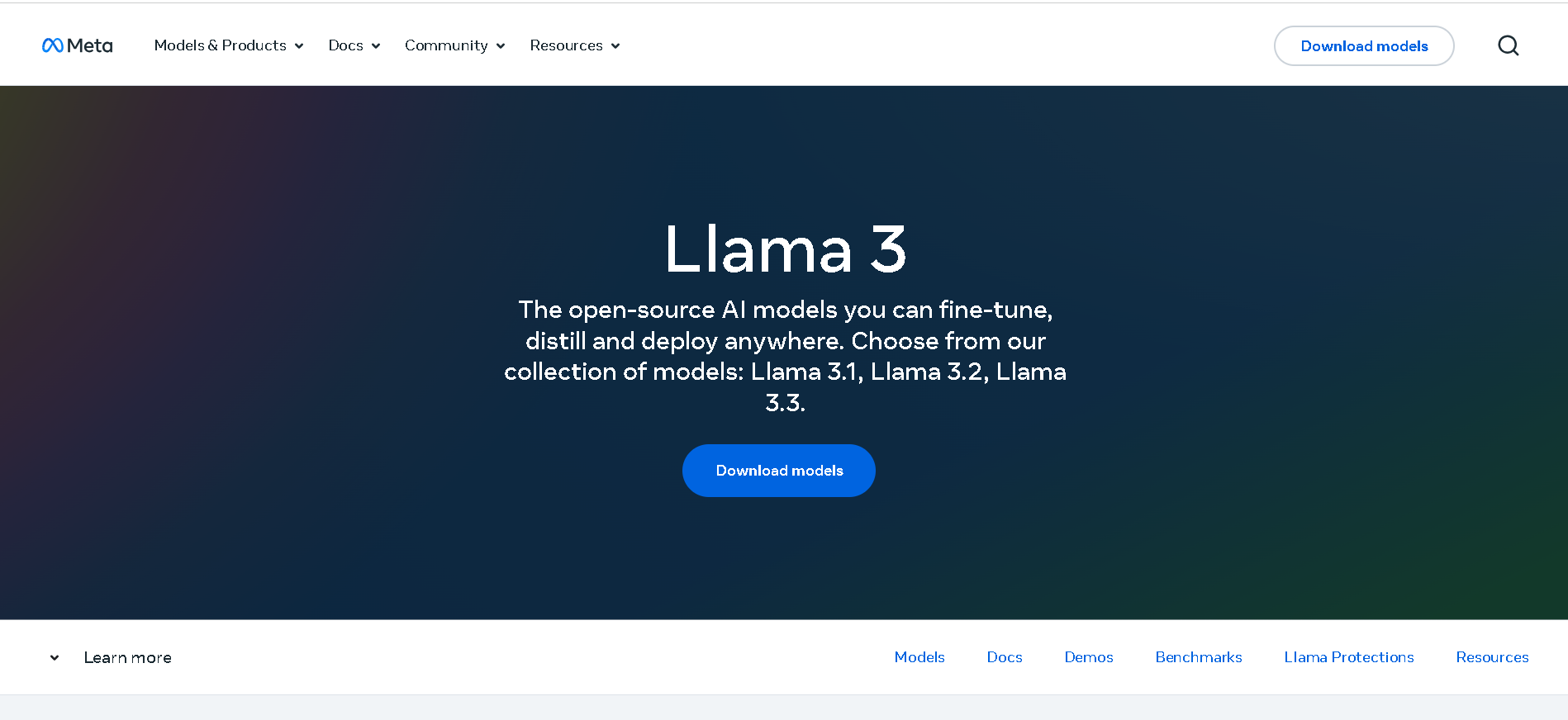
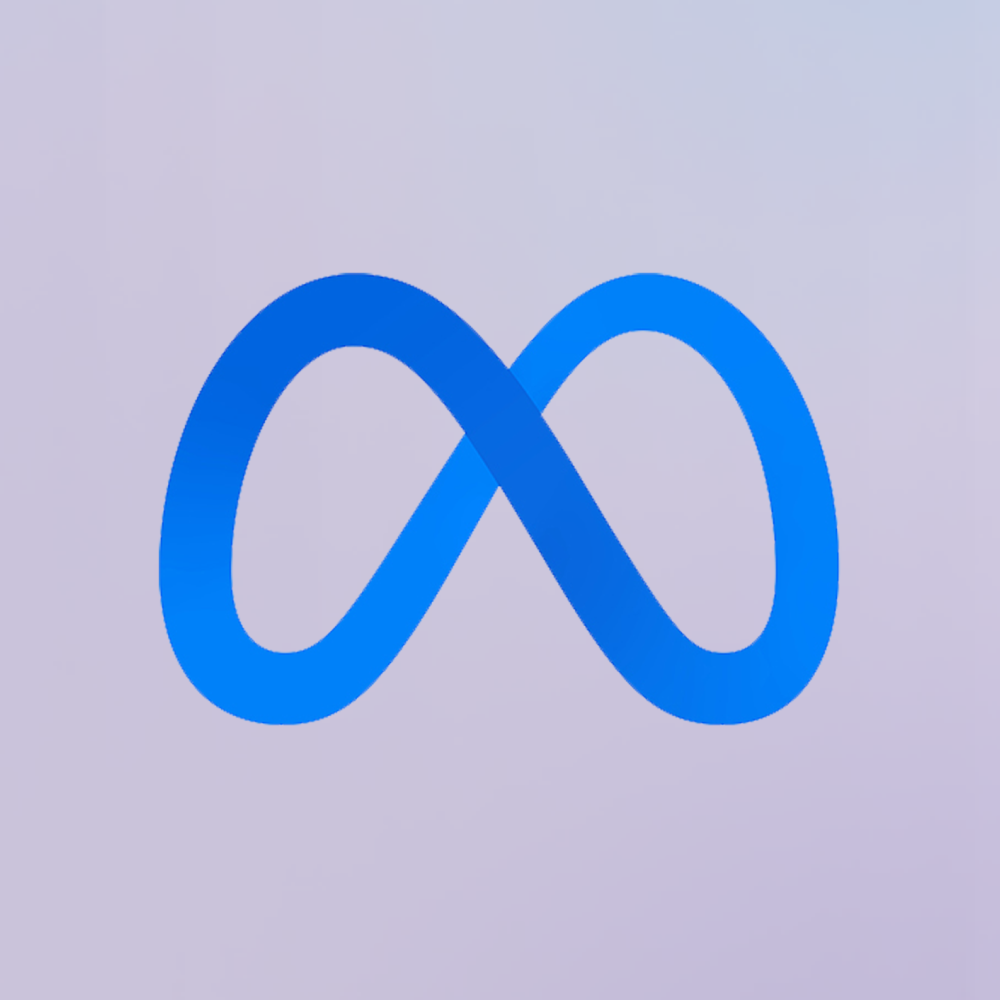
Meta Llama 3
Meta Llama 3 is Meta’s third-generation open-weight large language model family, released in April 2024 and enhanced in July 2024 with the 3.1 update. It spans three sizes—8B, 70B, and 405B parameters—each offering a 128K‑token context window. Llama 3 excels at reasoning, code generation, multilingual text, and instruction-following, and introduces multimodal vision (image understanding) capabilities in its 3.2 series. Robust safety mechanisms like Llama Guard 3, Code Shield, and CyberSec Eval 2 ensure responsible output.


Meta Llama 3
Meta Llama 3 is Meta’s third-generation open-weight large language model family, released in April 2024 and enhanced in July 2024 with the 3.1 update. It spans three sizes—8B, 70B, and 405B parameters—each offering a 128K‑token context window. Llama 3 excels at reasoning, code generation, multilingual text, and instruction-following, and introduces multimodal vision (image understanding) capabilities in its 3.2 series. Robust safety mechanisms like Llama Guard 3, Code Shield, and CyberSec Eval 2 ensure responsible output.


Meta Llama 3
Meta Llama 3 is Meta’s third-generation open-weight large language model family, released in April 2024 and enhanced in July 2024 with the 3.1 update. It spans three sizes—8B, 70B, and 405B parameters—each offering a 128K‑token context window. Llama 3 excels at reasoning, code generation, multilingual text, and instruction-following, and introduces multimodal vision (image understanding) capabilities in its 3.2 series. Robust safety mechanisms like Llama Guard 3, Code Shield, and CyberSec Eval 2 ensure responsible output.
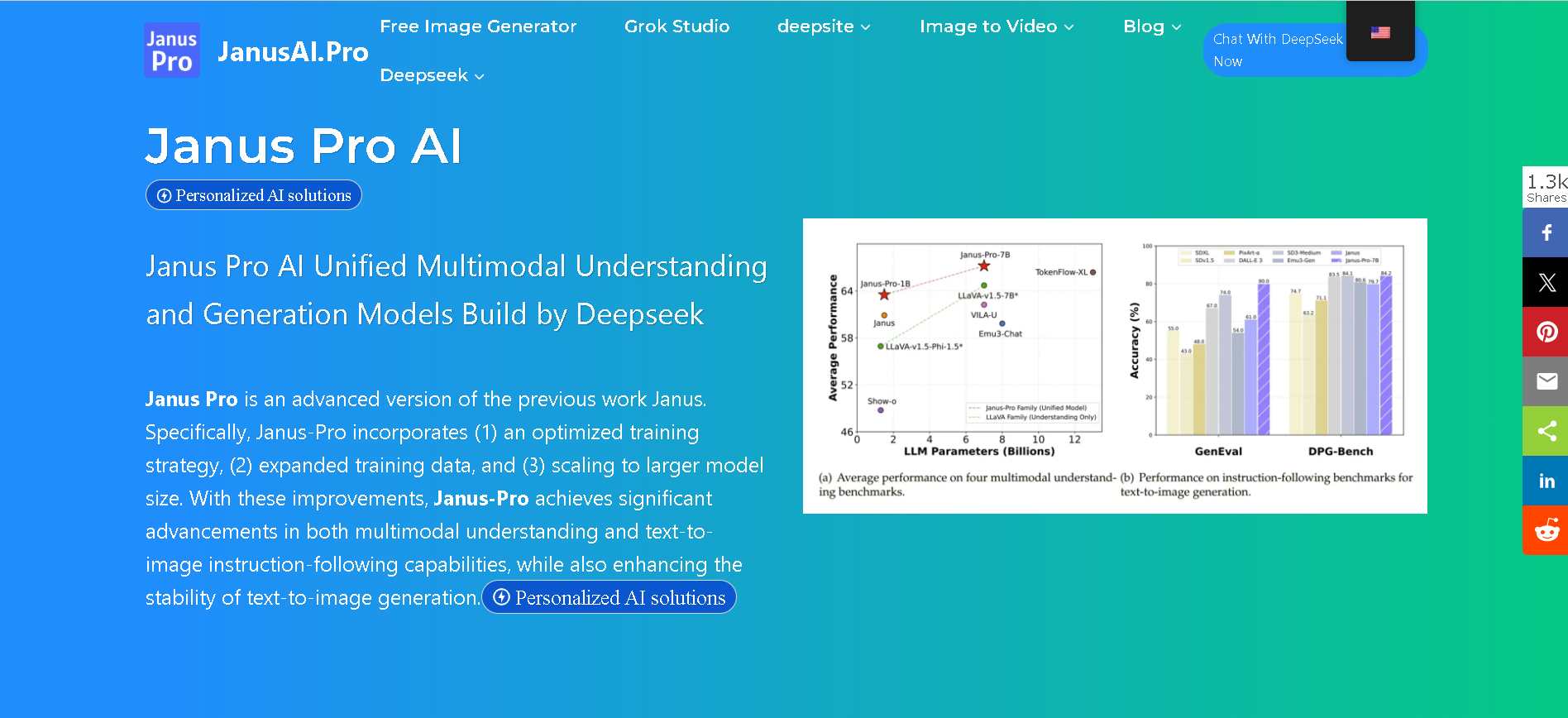
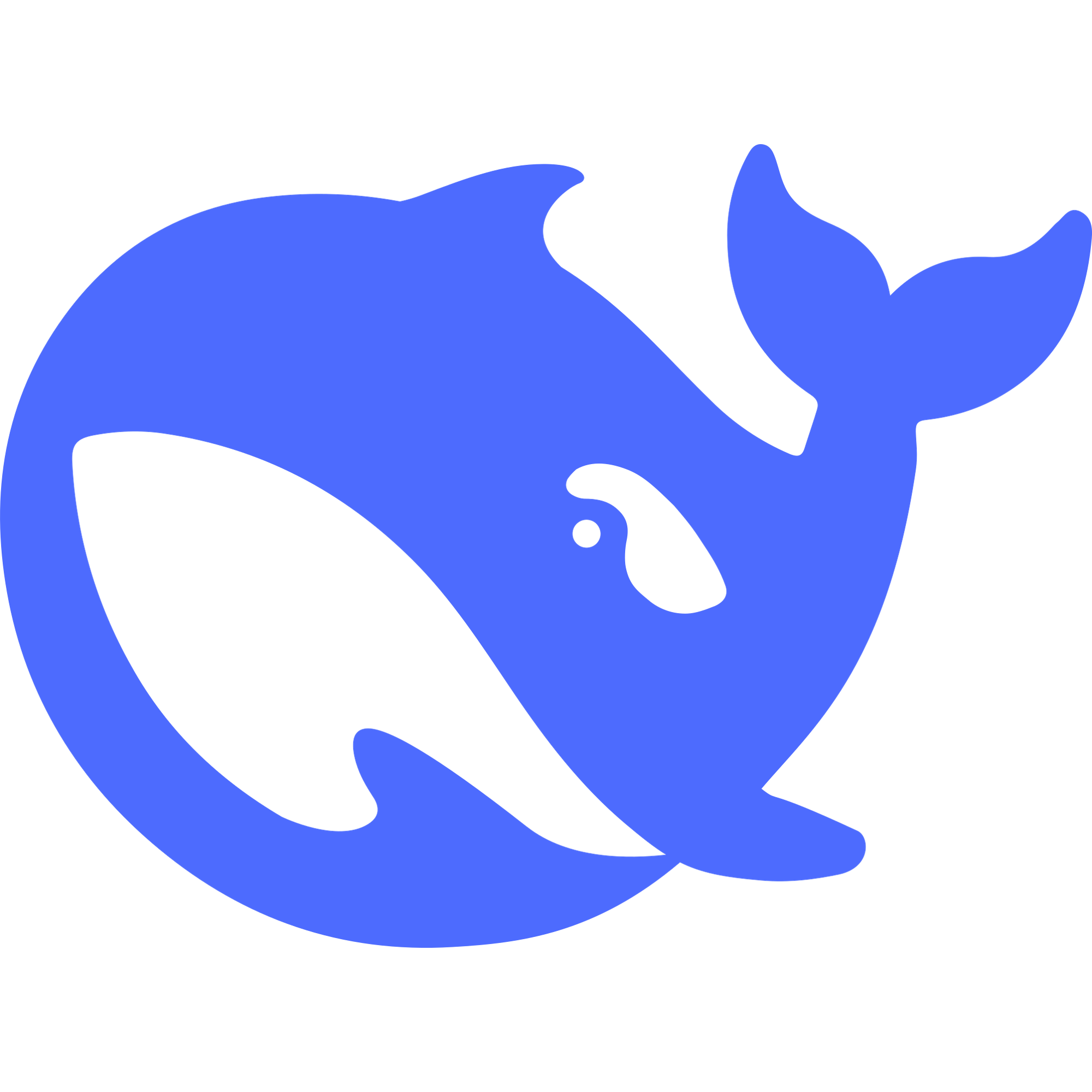
Janus-Pro-7B
anus Pro 7B is DeepSeek’s flagship open-source multimodal AI model, unifying vision understanding and text-to-image generation within a single transformer architecture. Built on DeepSeek‑LLM‑7B, it uses a decoupled visual encoding approach paired with SigLIP‑L and VQ tokenizer, delivering superior visual fidelity, prompt alignment, and stability across tasks—benchmarked ahead of OpenAI’s DALL‑E 3 and Stable Diffusion variants.


Janus-Pro-7B
anus Pro 7B is DeepSeek’s flagship open-source multimodal AI model, unifying vision understanding and text-to-image generation within a single transformer architecture. Built on DeepSeek‑LLM‑7B, it uses a decoupled visual encoding approach paired with SigLIP‑L and VQ tokenizer, delivering superior visual fidelity, prompt alignment, and stability across tasks—benchmarked ahead of OpenAI’s DALL‑E 3 and Stable Diffusion variants.


Janus-Pro-7B
anus Pro 7B is DeepSeek’s flagship open-source multimodal AI model, unifying vision understanding and text-to-image generation within a single transformer architecture. Built on DeepSeek‑LLM‑7B, it uses a decoupled visual encoding approach paired with SigLIP‑L and VQ tokenizer, delivering superior visual fidelity, prompt alignment, and stability across tasks—benchmarked ahead of OpenAI’s DALL‑E 3 and Stable Diffusion variants.
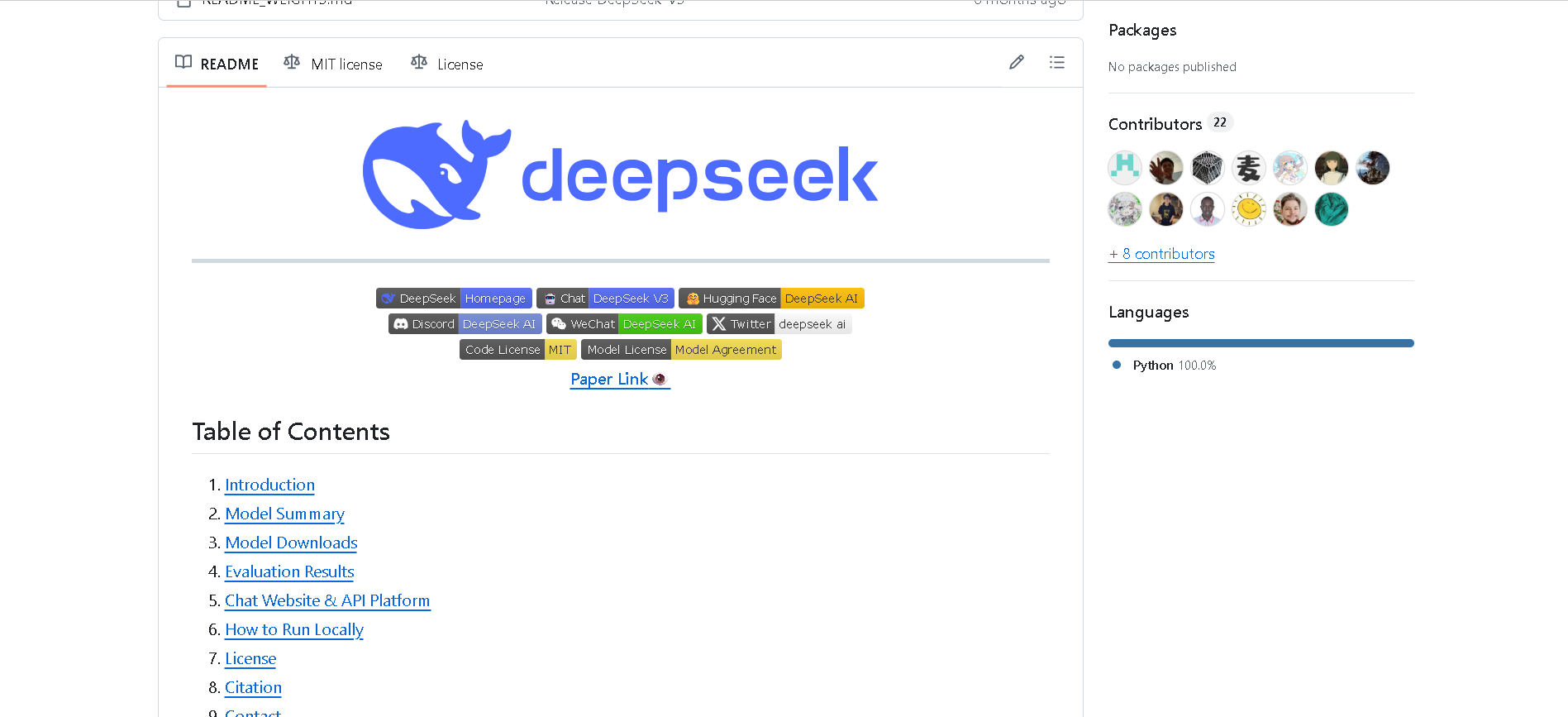
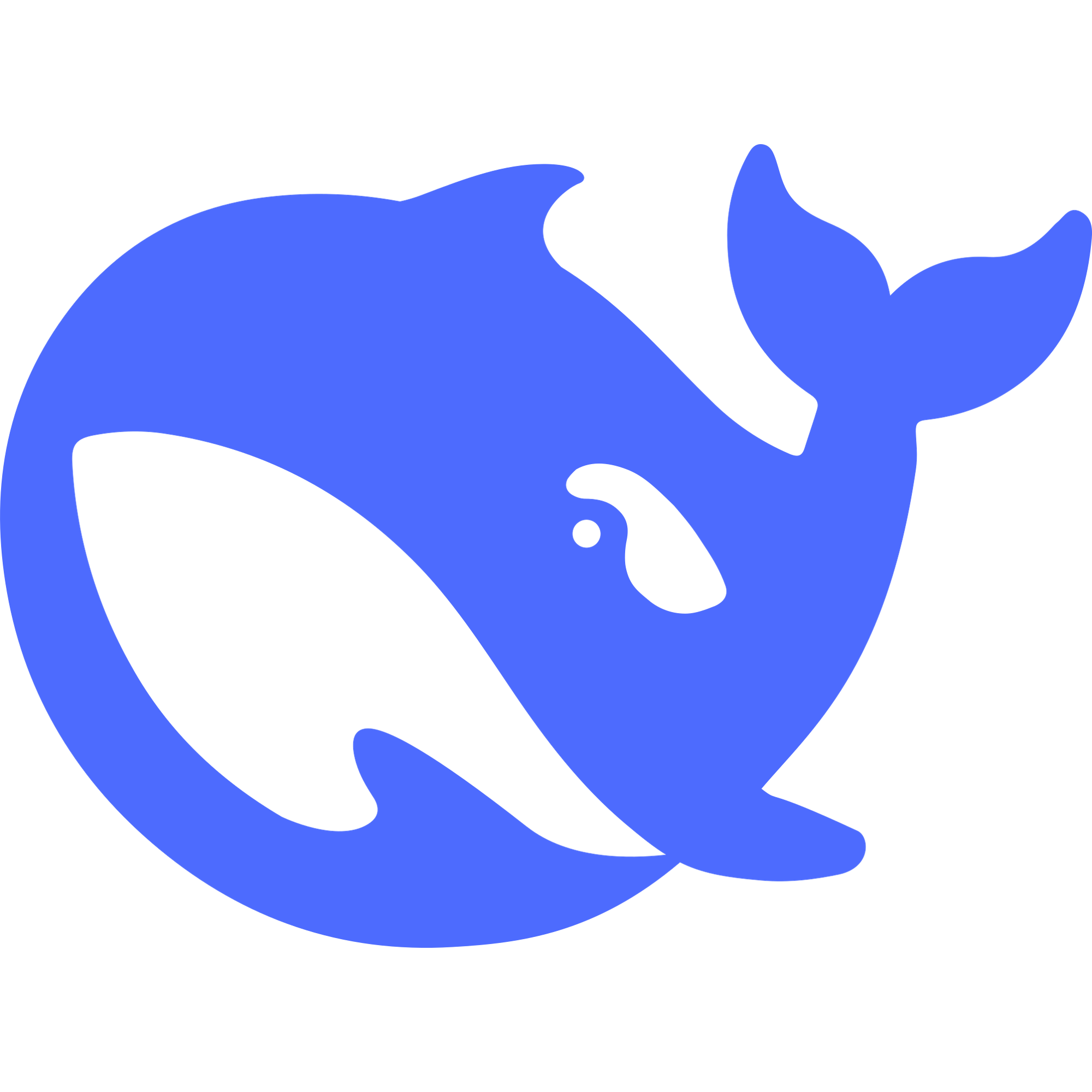
DeepSeek-V3
DeepSeek V3 is the latest flagship Mixture‑of‑Experts (MoE) open‑source AI model from DeepSeek. It features 671 billion total parameters (with ~37 billion activated per token), supports up to 128K context length, and excels across reasoning, code generation, language, and multimodal tasks. On standard benchmarks, it rivals or exceeds proprietary models—including GPT‑4o and Claude 3.5—as a high-performance, cost-efficient alternative.


DeepSeek-V3
DeepSeek V3 is the latest flagship Mixture‑of‑Experts (MoE) open‑source AI model from DeepSeek. It features 671 billion total parameters (with ~37 billion activated per token), supports up to 128K context length, and excels across reasoning, code generation, language, and multimodal tasks. On standard benchmarks, it rivals or exceeds proprietary models—including GPT‑4o and Claude 3.5—as a high-performance, cost-efficient alternative.


DeepSeek-V3
DeepSeek V3 is the latest flagship Mixture‑of‑Experts (MoE) open‑source AI model from DeepSeek. It features 671 billion total parameters (with ~37 billion activated per token), supports up to 128K context length, and excels across reasoning, code generation, language, and multimodal tasks. On standard benchmarks, it rivals or exceeds proprietary models—including GPT‑4o and Claude 3.5—as a high-performance, cost-efficient alternative.
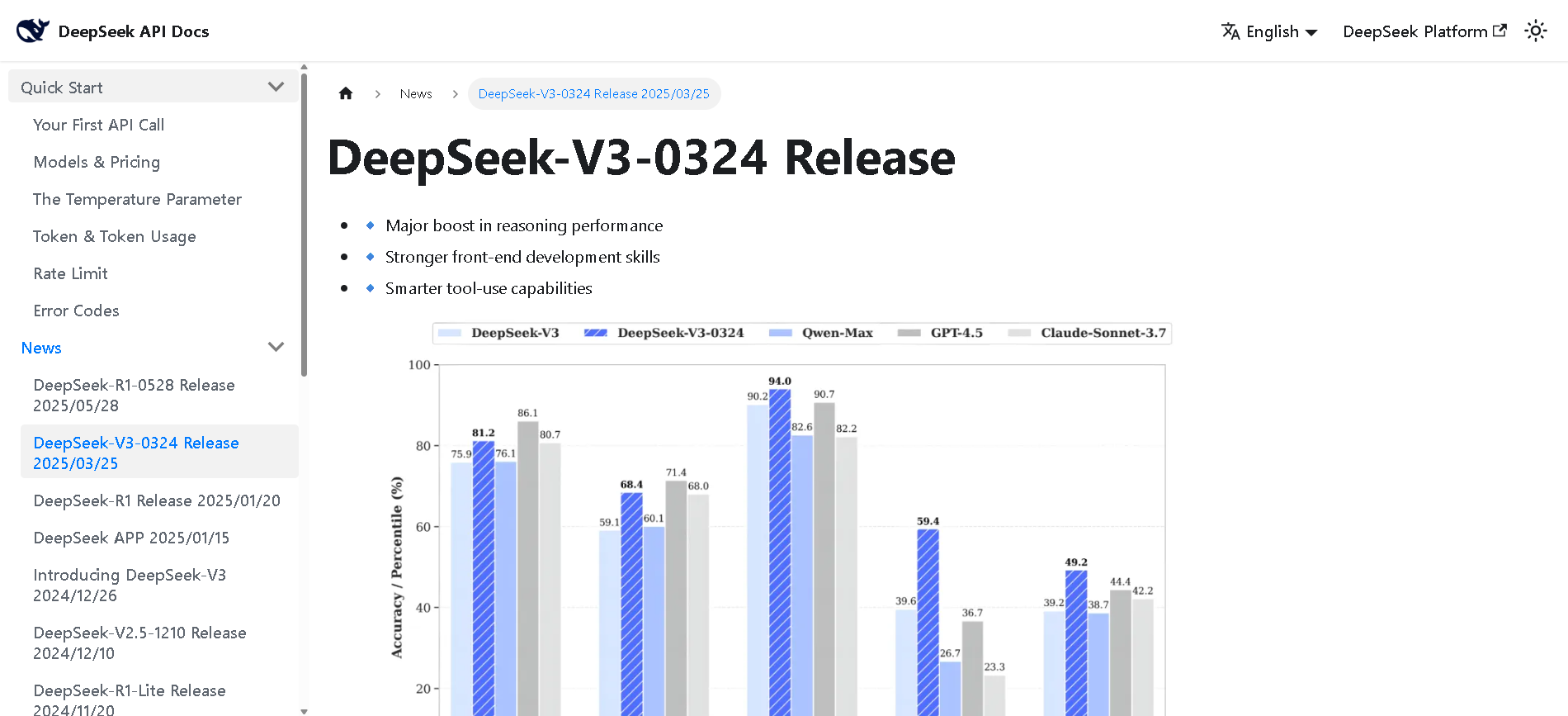
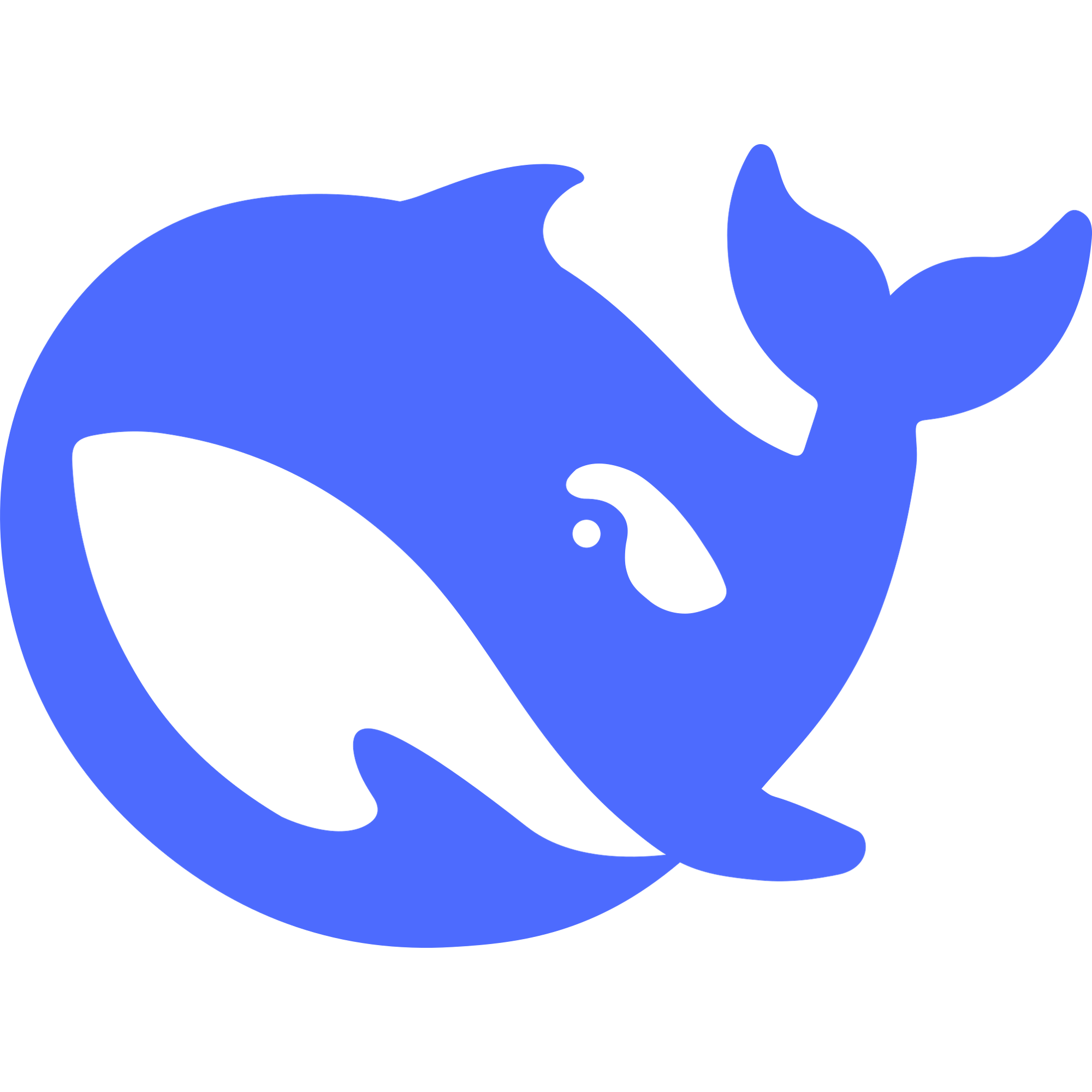
DeepSeek-V3-0324
DeepSeek V3 (0324) is the latest open-source Mixture-of-Experts (MoE) language model from DeepSeek, featuring 671B parameters (37B active per token). Released in March 2025 under the MIT license, it builds on DeepSeek V3 with major enhancements in reasoning, coding, front-end generation, and Chinese proficiency. It maintains cost-efficiency and function-calling support.


DeepSeek-V3-0324
DeepSeek V3 (0324) is the latest open-source Mixture-of-Experts (MoE) language model from DeepSeek, featuring 671B parameters (37B active per token). Released in March 2025 under the MIT license, it builds on DeepSeek V3 with major enhancements in reasoning, coding, front-end generation, and Chinese proficiency. It maintains cost-efficiency and function-calling support.


DeepSeek-V3-0324
DeepSeek V3 (0324) is the latest open-source Mixture-of-Experts (MoE) language model from DeepSeek, featuring 671B parameters (37B active per token). Released in March 2025 under the MIT license, it builds on DeepSeek V3 with major enhancements in reasoning, coding, front-end generation, and Chinese proficiency. It maintains cost-efficiency and function-calling support.
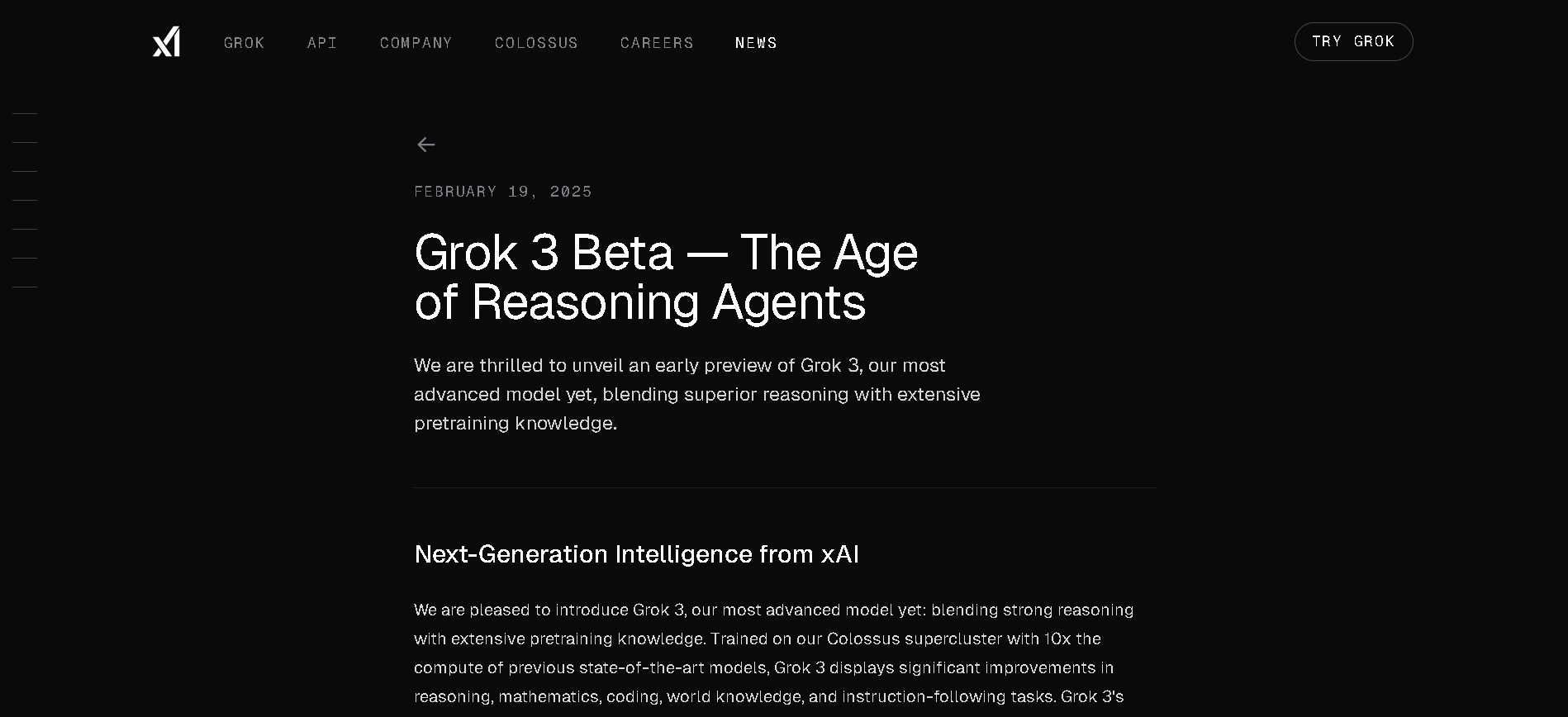
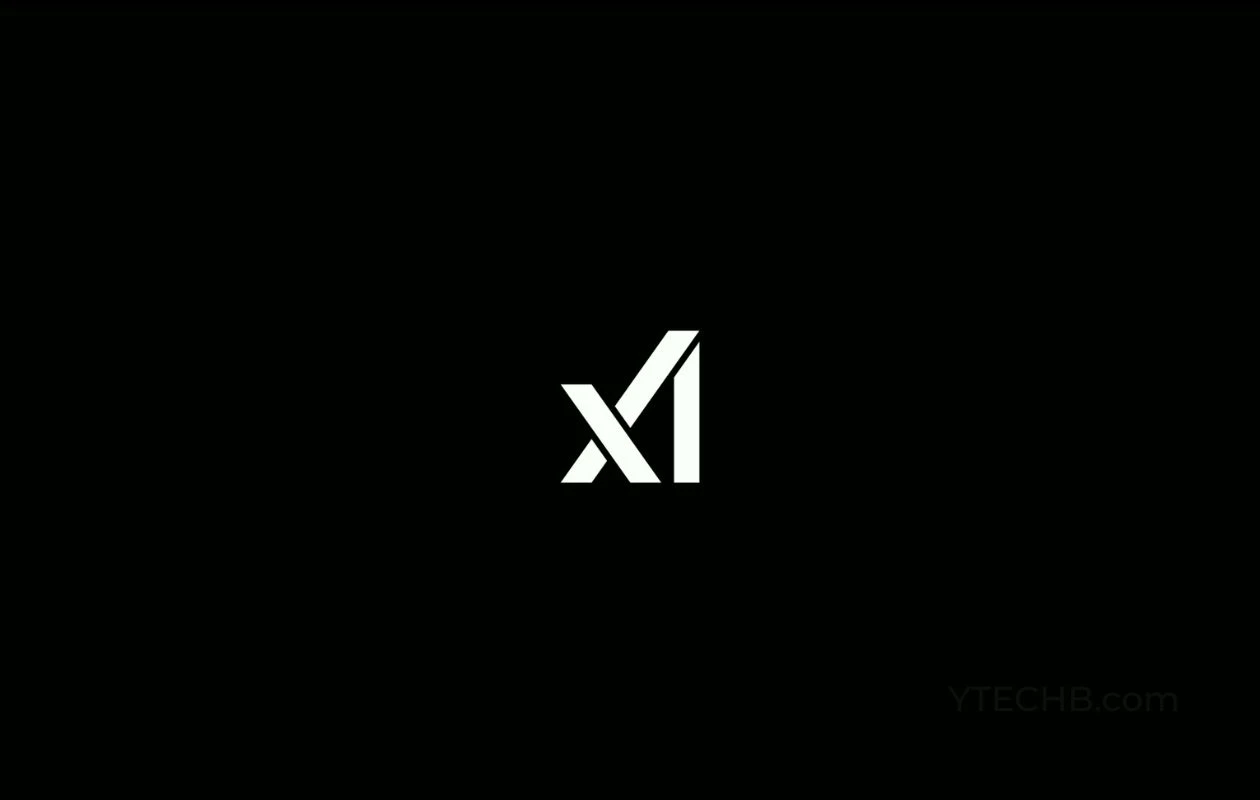
Grok 3 Latest
Grok 3 is xAI’s newest flagship AI chatbot, released on February 17, 2025, running on the massive Colossus supercluster (~200,000 GPUs). It offers elite-level reasoning, chain-of-thought transparency (“Think” mode), advanced “Big Brain” deeper reasoning, multimodal support (text, images), and integrated real-time DeepSearch—positioning it as a top-tier competitor to GPT‑4o, Gemini, Claude, and DeepSeek V3 on benchmarks.


Grok 3 Latest
Grok 3 is xAI’s newest flagship AI chatbot, released on February 17, 2025, running on the massive Colossus supercluster (~200,000 GPUs). It offers elite-level reasoning, chain-of-thought transparency (“Think” mode), advanced “Big Brain” deeper reasoning, multimodal support (text, images), and integrated real-time DeepSearch—positioning it as a top-tier competitor to GPT‑4o, Gemini, Claude, and DeepSeek V3 on benchmarks.


Grok 3 Latest
Grok 3 is xAI’s newest flagship AI chatbot, released on February 17, 2025, running on the massive Colossus supercluster (~200,000 GPUs). It offers elite-level reasoning, chain-of-thought transparency (“Think” mode), advanced “Big Brain” deeper reasoning, multimodal support (text, images), and integrated real-time DeepSearch—positioning it as a top-tier competitor to GPT‑4o, Gemini, Claude, and DeepSeek V3 on benchmarks.
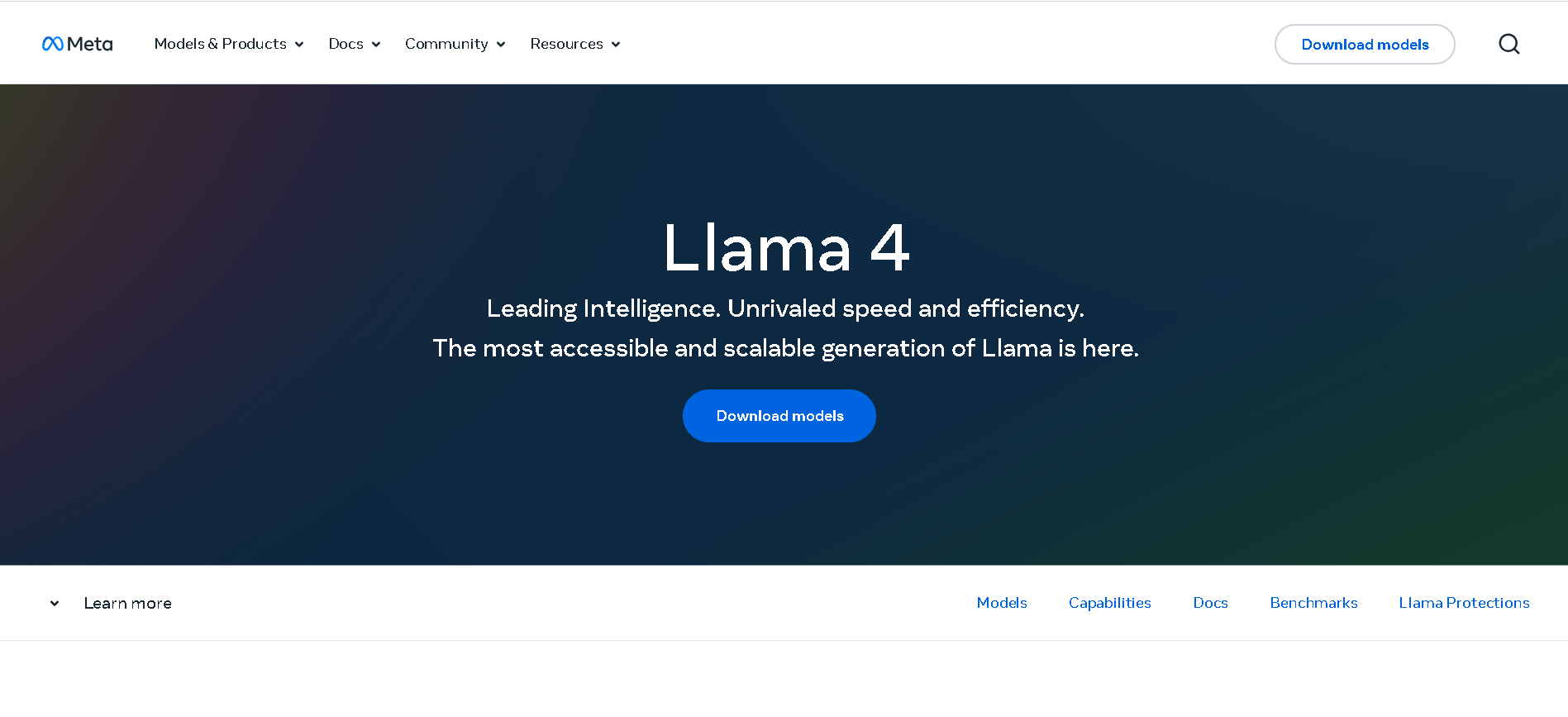

Meta Llama 4 Maver..
Llama 4 Maverick is Meta’s powerful mid-sized model in the Llama 4 series, released April 5, 2025. Built with a mixture-of-experts (MoE) architecture featuring 17 B active parameters (out of 400 B total) and 128 experts, it supports a 1 million-token context window and native multimodality for text and image inputs. It ranks near the top of competitive benchmarks—surpassing GPT‑4o and Gemini 2.0 Flash in reasoning, coding, and visual tasks.


Meta Llama 4 Maver..
Llama 4 Maverick is Meta’s powerful mid-sized model in the Llama 4 series, released April 5, 2025. Built with a mixture-of-experts (MoE) architecture featuring 17 B active parameters (out of 400 B total) and 128 experts, it supports a 1 million-token context window and native multimodality for text and image inputs. It ranks near the top of competitive benchmarks—surpassing GPT‑4o and Gemini 2.0 Flash in reasoning, coding, and visual tasks.


Meta Llama 4 Maver..
Llama 4 Maverick is Meta’s powerful mid-sized model in the Llama 4 series, released April 5, 2025. Built with a mixture-of-experts (MoE) architecture featuring 17 B active parameters (out of 400 B total) and 128 experts, it supports a 1 million-token context window and native multimodality for text and image inputs. It ranks near the top of competitive benchmarks—surpassing GPT‑4o and Gemini 2.0 Flash in reasoning, coding, and visual tasks.
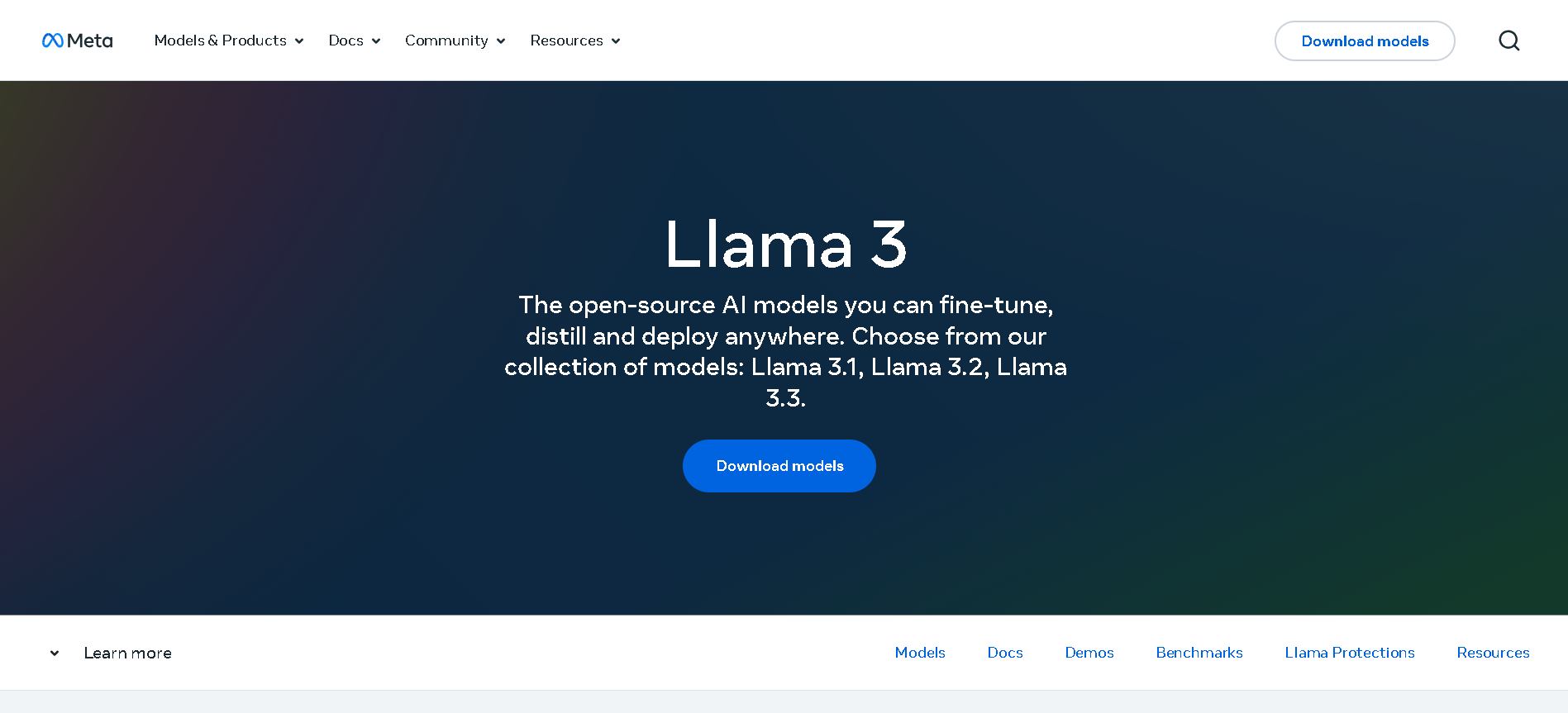

Meta Llama 3.2
Llama 3.2 is Meta’s multimodal and lightweight update to its Llama 3 line, released on September 25, 2024. The family includes 1B and 3B text-only models optimized for edge devices, as well as 11B and 90B Vision models capable of image understanding. It offers a 128K-token context window, Grouped-Query Attention for efficient inference, and opens up on-device, private AI with strong multilingual (e.g. Hindi, Spanish) support.


Meta Llama 3.2
Llama 3.2 is Meta’s multimodal and lightweight update to its Llama 3 line, released on September 25, 2024. The family includes 1B and 3B text-only models optimized for edge devices, as well as 11B and 90B Vision models capable of image understanding. It offers a 128K-token context window, Grouped-Query Attention for efficient inference, and opens up on-device, private AI with strong multilingual (e.g. Hindi, Spanish) support.


Meta Llama 3.2
Llama 3.2 is Meta’s multimodal and lightweight update to its Llama 3 line, released on September 25, 2024. The family includes 1B and 3B text-only models optimized for edge devices, as well as 11B and 90B Vision models capable of image understanding. It offers a 128K-token context window, Grouped-Query Attention for efficient inference, and opens up on-device, private AI with strong multilingual (e.g. Hindi, Spanish) support.
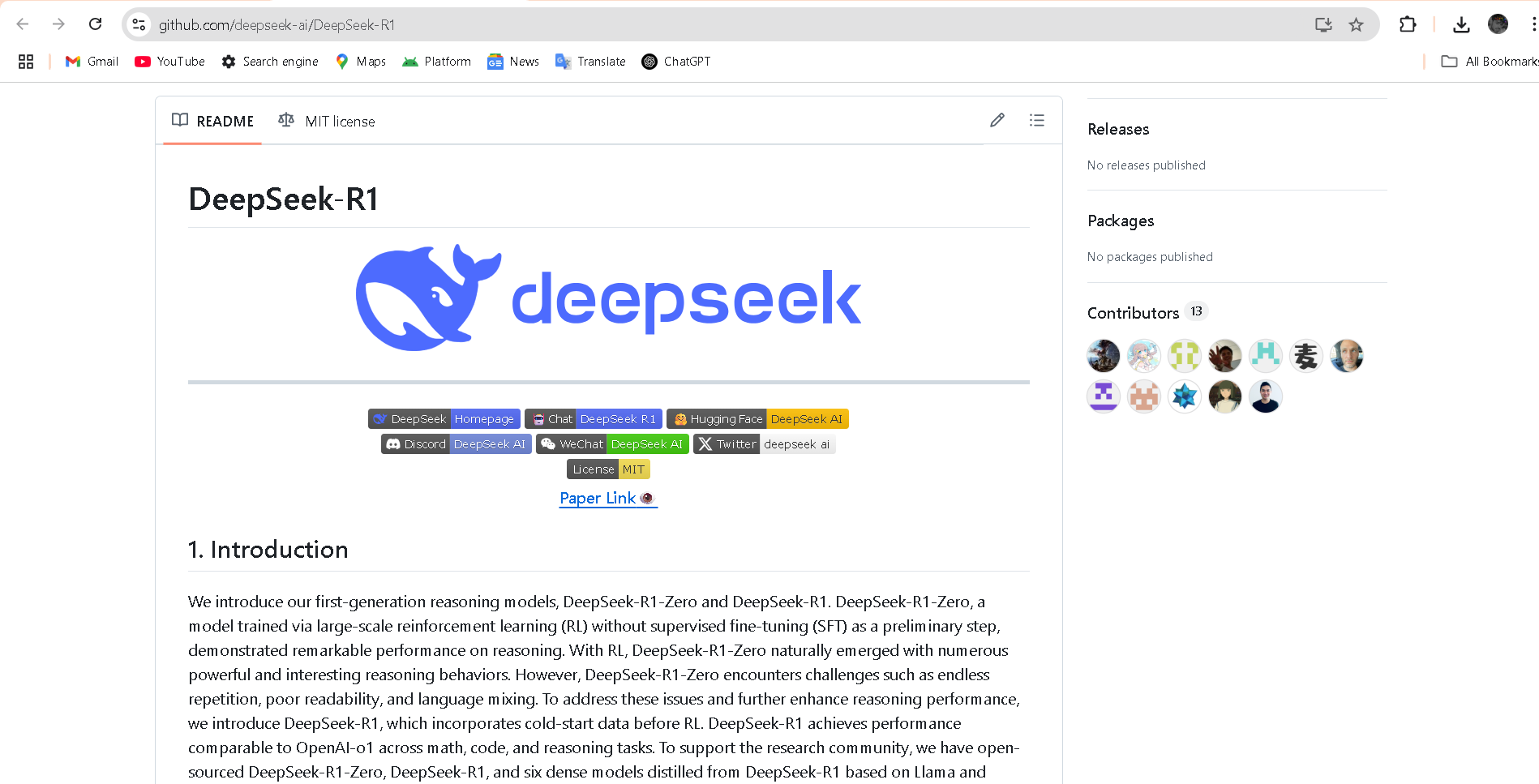
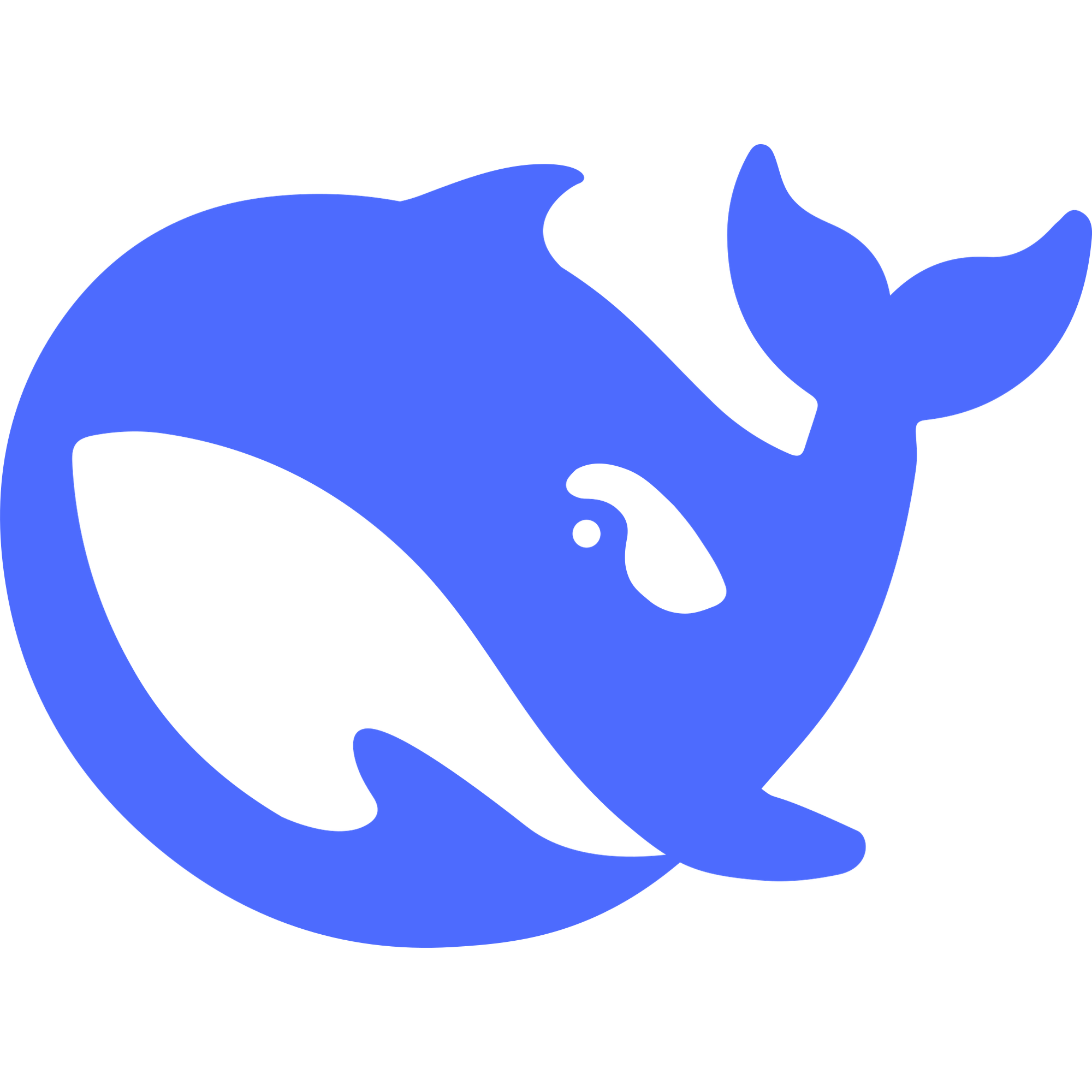
DeepSeek-R1-Zero
DeepSeek R1 Zero is an open-source large language model introduced in January 2025 by DeepSeek AI. It is a reinforcement learning–only version of DeepSeek R1, trained without supervised fine-tuning. With 671B total parameters (37B active) and a 128K-token context window, it demonstrates strong chain-of-thought reasoning, self-verification, and reflection.


DeepSeek-R1-Zero
DeepSeek R1 Zero is an open-source large language model introduced in January 2025 by DeepSeek AI. It is a reinforcement learning–only version of DeepSeek R1, trained without supervised fine-tuning. With 671B total parameters (37B active) and a 128K-token context window, it demonstrates strong chain-of-thought reasoning, self-verification, and reflection.


DeepSeek-R1-Zero
DeepSeek R1 Zero is an open-source large language model introduced in January 2025 by DeepSeek AI. It is a reinforcement learning–only version of DeepSeek R1, trained without supervised fine-tuning. With 671B total parameters (37B active) and a 128K-token context window, it demonstrates strong chain-of-thought reasoning, self-verification, and reflection.
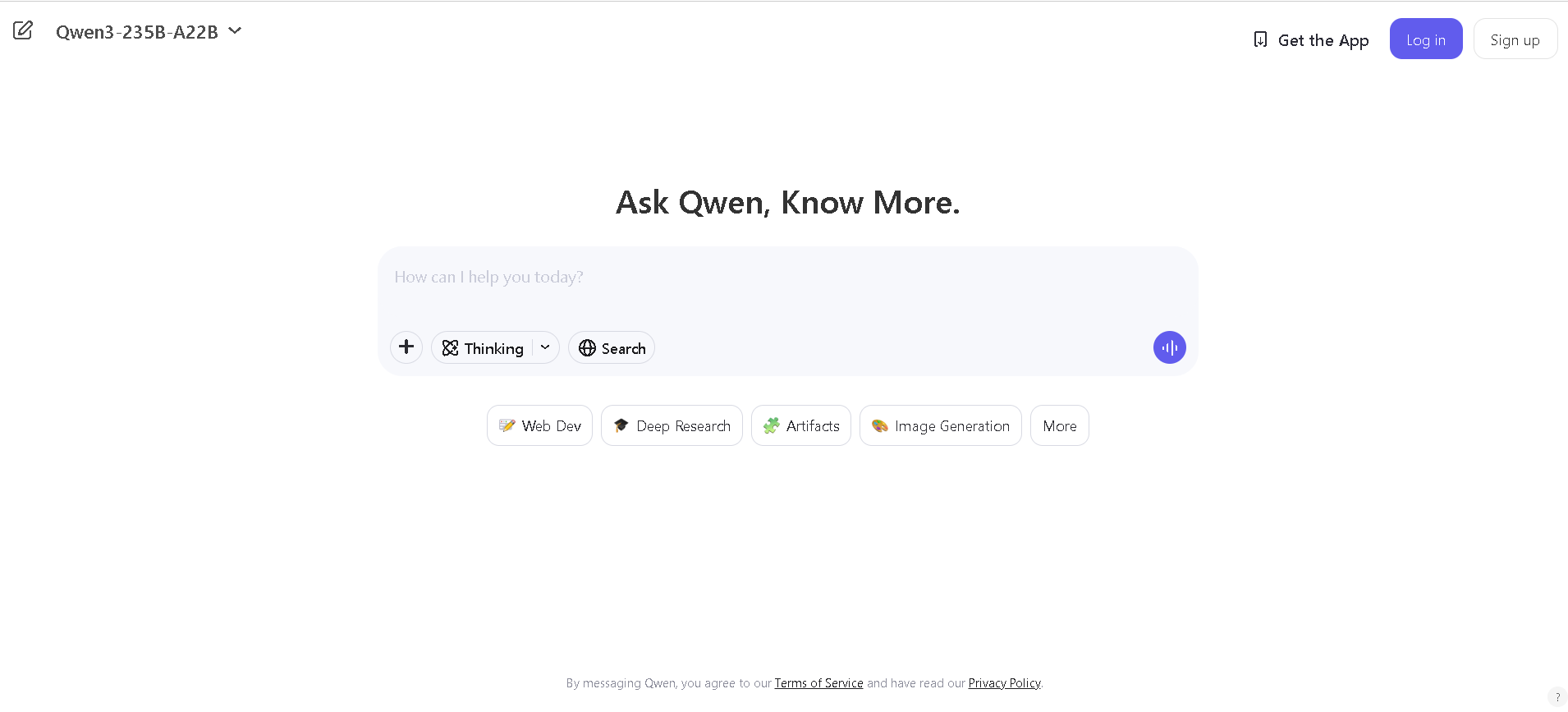
Qwen Chat
Qwen Chat is Alibaba Cloud’s conversational AI assistant built on the Qwen series (e.g., Qwen‑7B‑Chat, Qwen1.5‑7B‑Chat, Qwen‑VL, Qwen‑Audio, and Qwen2.5‑Omni). It supports text, vision, audio, and video understanding, plus image and document processing, web search integration, and image generation—all through a unified chat interface.

Qwen Chat
Qwen Chat is Alibaba Cloud’s conversational AI assistant built on the Qwen series (e.g., Qwen‑7B‑Chat, Qwen1.5‑7B‑Chat, Qwen‑VL, Qwen‑Audio, and Qwen2.5‑Omni). It supports text, vision, audio, and video understanding, plus image and document processing, web search integration, and image generation—all through a unified chat interface.

Qwen Chat
Qwen Chat is Alibaba Cloud’s conversational AI assistant built on the Qwen series (e.g., Qwen‑7B‑Chat, Qwen1.5‑7B‑Chat, Qwen‑VL, Qwen‑Audio, and Qwen2.5‑Omni). It supports text, vision, audio, and video understanding, plus image and document processing, web search integration, and image generation—all through a unified chat interface.
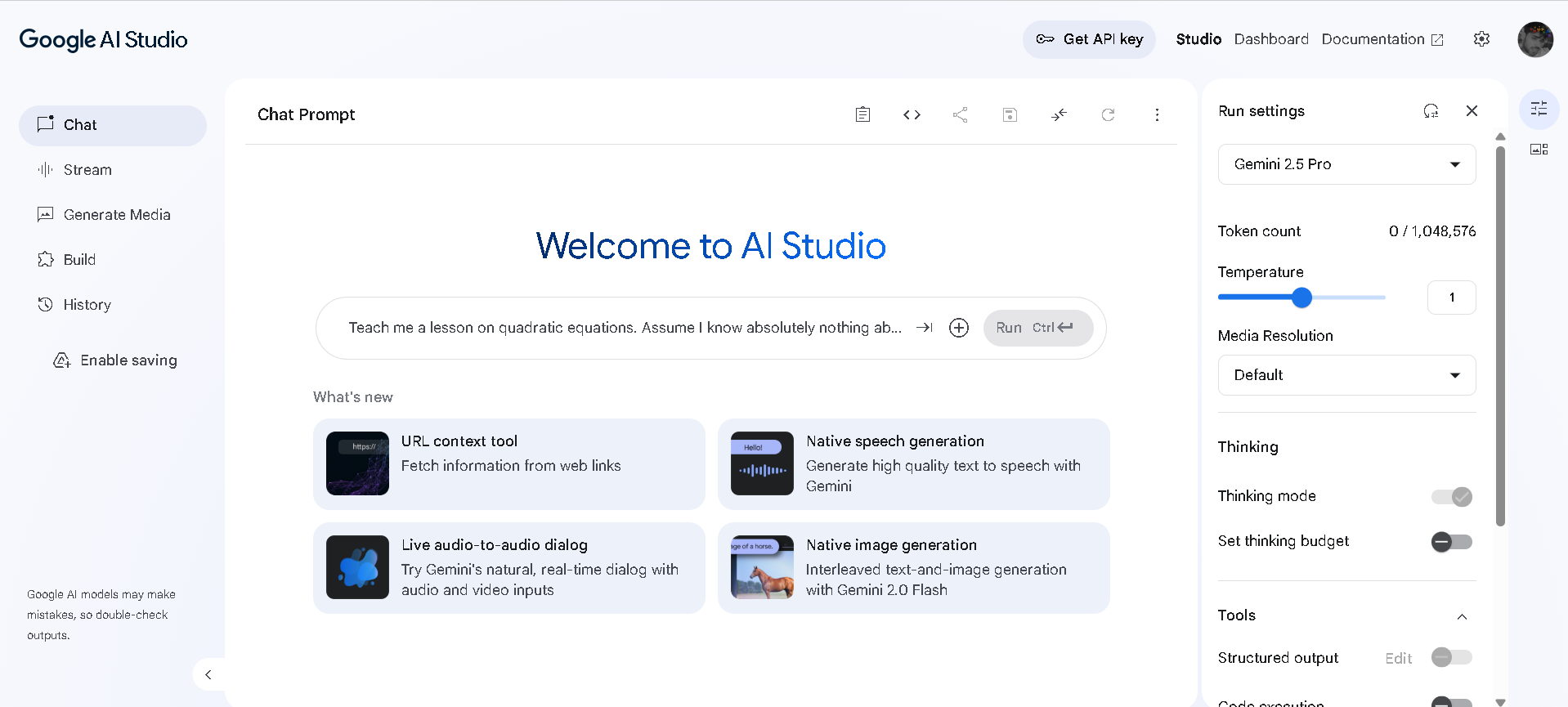

Google AI Studio
Google AI Studio is a web-based development environment that allows users to explore, prototype, and build applications using Google's cutting-edge generative AI models, such as Gemini. It provides a comprehensive set of tools for interacting with AI through chat prompts, generating various media types, and fine-tuning model behaviors for specific use cases.


Google AI Studio
Google AI Studio is a web-based development environment that allows users to explore, prototype, and build applications using Google's cutting-edge generative AI models, such as Gemini. It provides a comprehensive set of tools for interacting with AI through chat prompts, generating various media types, and fine-tuning model behaviors for specific use cases.


Google AI Studio
Google AI Studio is a web-based development environment that allows users to explore, prototype, and build applications using Google's cutting-edge generative AI models, such as Gemini. It provides a comprehensive set of tools for interacting with AI through chat prompts, generating various media types, and fine-tuning model behaviors for specific use cases.
Editorial Note
This page was researched and written by the ATB Editorial Team. Our team researches each AI tool by reviewing its official website, testing features, exploring real use cases, and considering user feedback. Every page is fact-checked and regularly updated to ensure the information stays accurate, neutral, and useful for our readers.
If you have any suggestions or questions, email us at hello@aitoolbook.ai
